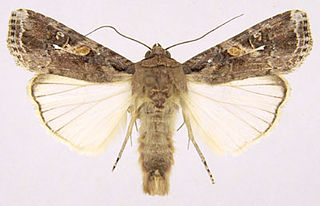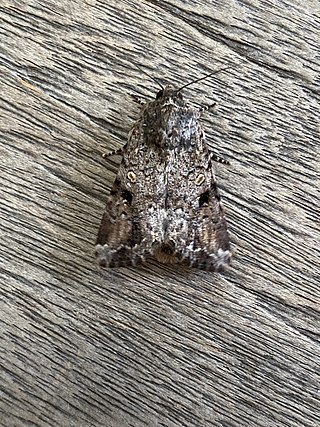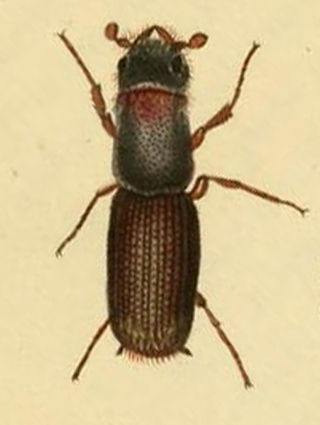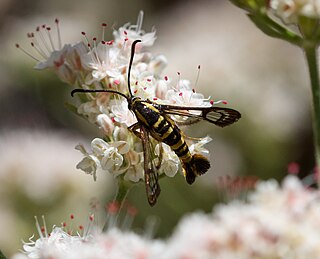


Frass refers loosely to the more or less solid excreta of insects, and to certain other related matter.



Frass refers loosely to the more or less solid excreta of insects, and to certain other related matter.
Frass is an informal term and accordingly it is variously used and variously defined. It is derived from the German word Fraß, which means the food takeup of an animal. [1] The English usage applies to excreted residues of anything that insects had eaten, and similarly, to other chewed or mined refuse that insects leave behind. It does not generally refer to fluids such as honeydew, but the point does not generally arise, and is largely ignored in this article.
Such usage in English originated in the mid-nineteenth century at the latest. [2] [3] Modern technical English sources differ on the precise definition, though there is little direct contradiction on the practical realities. One glossary from the early twentieth century speaks of "...excrement; usually the excreted pellets of caterpillars." [4] In some contexts frass refers primarily to fine, masticated material, often powdery, that phytophagous insects pass as indigestible waste after they have processed plant tissues as completely as their physiology would permit. [5] Other common examples of frass types include the fecal material that larvae of codling moths leave as they feed inside fruit or seed, or that Terastia meticulosalis larvae leave as they bore in the pith of Erythrina twigs.
Various forms of frass may result from the nature of the food and the digestive systems of the species of insect that excreted the material. For example, many caterpillars, especially large, leaf-eating caterpillars in families such as Saturniidae, produce quite elaborately moulded pellets that may be conspicuous on the ground beneath plants in which they feed. In the tunnels they eat in the leaves, leaf miners commonly leave visible amorphous frass residues of the pulp of the mesophyll. Their frass commonly does not fill the tunnel.
In contrast, larvae of most powder post beetles (Lyctus) partly eject their finely granular frass from their tunnels when boring in the wood on which they feed, while the larvae of most dry-wood Cerambycidae leave their frass packed tightly into the tunnels behind them. Many other species of wood borers also leave the tunnels behind them tightly packed with dry frass, which may be either finely powdery or coarsely sawdusty. Possibly this is a defence against other borer larvae, many species of which are cannibalistic, or it might reduce attacks from some kinds of predatory mites or soak up fluids that a live tree might secrete into the tunnel.
Loose, fibrous frass of some moths in the family Cossidae, such as Coryphodema tristis , may be seen protruding from the mouths of their tunnels in tree trunks, especially shortly before they emerge as adult moths. In this respect, their frass differs from the powdery frass of powder post beetles such as Lyctus.
Borer tunnels may occur either in dry or rotting wood or under bark, in the comparatively soft, nutritious bast tissue, either dead or living.
Some boring insects do not digest the wood or other medium itself, but bore tunnels in which yeasts or other fungi grow, possibly stimulated by excretions and secretions of the insects. Such tunnels obviously cannot be permitted to become clogged, or the insects could not access their own pastures, so they must either eject at least part of their frass, or otherwise leave room for the edible growth. Examples of such boring-insect/fungal associations include ambrosia beetles with ambrosia fungi, the Sirex noctilio with its fungal partner Amylostereum areolatum , and more. [6]
In a significantly different sense the term "frass" also may refer to excavated wood shavings that carpenter ants, carpenter bees and other insects with similar wood-boring habits eject from their galleries during the tunneling process. Such material differs from the frass residues of foods, because insects that tunnel to construct such nests do not eat the wood, so the material that they discard as they tunnel has not passed through their gut. [7] Even professional entomologists might need suitable instruments and detailed examination to distinguish this from food-derived frass.
Contact with frass causes plants to secrete chitinase in response to its high chitin levels. Some frass, such as that of the fall armyworm, can also reduce plants' herbivory defenses. [8] Frass is a microbial inoculant, in particular a soil inoculant, a source of desirable microbes, that promotes the formation of compost. [9]
Many insect species, usually in their larval stages, accumulate their frass and cover themselves with it either to disguise their presence, or as a repugnatorial covering.

Bookworm is a general name for any insect that is said to bore through books.

A woodworm is the wood-eating larva of many species of beetle. It is also a generic description given to the infestation of a wooden item by these larvae.

The deathwatch beetle is a species of woodboring beetle that sometimes infests the structural timbers of old buildings. The adult beetle is brown and measures on average 7 mm (0.3 in) long. Eggs are laid in dark crevices in old wood inside buildings, trees, and inside tunnels left behind by previous larvae. The larvae bore into the timber, feeding for up to ten years before pupating, and later emerging from the wood as adult beetles. Timber that has been damp and is affected by fungal decay is soft enough for the larvae to chew through. They obtain nourishment by using enzymes present in their gut to digest the cellulose and hemicellulose in the wood.

Powderpost beetles are a group of seventy species of woodboring beetles classified in the insect subfamily Lyctinae. These beetles, along with spider beetles, death watch beetles, common furniture beetles, skin beetles, and others, make up the superfamily Bostrichoidea. While most woodborers have a large prothorax, powderpost beetles do not, making their heads more visible. In addition to this, their antennae have two-jointed clubs. They are considered pests and attack deciduous trees, over time reducing the wood to a powdery dust. The damage caused by longhorn beetles is often confused with that of powderpost beetles, but the two groups are unrelated. The larvae of the Cerambycidae are white, straight and generally flat-headed, whereas those of the Bostrichidae are white and C-shaped.

The term woodboring beetle encompasses many species and families of beetles whose larval or adult forms eat and destroy wood. In the woodworking industry, larval stages of some are sometimes referred to as woodworms. The three most species-rich families of woodboring beetles are longhorn beetles, bark beetles and weevils, and metallic flat-headed borers. Woodboring is thought to be the ancestral ecology of beetles, and bores made by beetles in fossil wood extend back to the earliest fossil record of beetles in the Early Permian (Asselian), around 295-300 million years ago.

Hylotrupes is a monotypic genus of woodboring beetles in the family Cerambycidae, the longhorn beetles. The sole species, Hylotrupes bajulus, is known by several common names, including house longhorn beetle, old house borer, and European house borer. In South Africa it also is known as the Italian beetle because of infested packing cases that had come from Italy. Hylotrupes is the only genus in the tribe Hylotrupini.

The spined soldier bug is a species of stink bug common in North America. They are predators of gypsy moth caterpillars and the larvae of beetles such as the Colorado potato beetle and the Mexican bean beetle. Since the Mexican bean beetle is widely regarded as a notorious agricultural pest in North America, soldier bugs are generally considered to be beneficial garden insects.
Home-stored product entomology is the study of insects that infest foodstuffs stored in the home. It deals with the prevention, detection and eradication of pests.

Dioryctria sylvestrella, the new pine knot-horn or maritime pine borer, is a moth of the family Pyralidae. It is found in Europe, parts of Asia and North Africa. The adult is a small mottled brown and white insect with a wingspan of 28 to 35 mm. The moth flies in a single generation from June to October and is a pest of maritime pine and several other species of pine, on which the caterpillars feed.

The fall armyworm is a species in the order Lepidoptera and one of the species of the fall armyworm moths distinguished by their larval life stage. The term "armyworm" can refer to several species, often describing the large-scale invasive behavior of the species' larval stage. It is regarded as a pest and can damage and destroy a wide variety of crops, which causes large economic damage. Its scientific name derives from frugiperda, which is Latin for lost fruit, named because of the species' ability to destroy crops. Because of its propensity for destruction, the fall armyworm's habits and possibilities for crop protection have been studied in depth. It is also a notable case for studying sympatric speciation, as it appears to be diverging into two species currently. Another remarkable trait of the larva is that they consistently practice cannibalism, despite its fitness costs.

Brithys crini, the amaryllis borer, crinum borer, lily borer or Kew arches, is a moth of the family Noctuidae. It is a garden pest in parts of its range, as their larvae damage the stems and leaves of lilies, especially lilies of the family Amaryllidaceae.

Spodoptera mauritia, the lawn armyworm or paddy swarming caterpillar, is a moth of the family Noctuidae. The species was first described by Jean Baptiste Boisduval in 1833. Able to eat many types of food, it is a major pest throughout the world.

Lyctus carbonarius is a wood-boring beetle in the family Bostrichidae, commonly known as the southern lyctus beetle. It is a serious pest of hardwoods including ash, hickory, oak, maple and mahogany and can infest many products in the home including hardwood flooring and structural timbers, plywood, furniture, tool handles, picture frames, baskets and ladders. Timber can be infested in one location and then be transported large distances by ship, after which the beetles can emerge and spread the infestation to new areas.

Busseola fusca is a species of moth that is also known as the maize stalk borer. It is known from Ethiopia.

Platypus apicalis, known by its common name the New Zealand pinhole boring beetle, is a wood-boring beetle endemic to New Zealand and found throughout the North and South Island in a range of environments.

Platypus cylindrus, commonly known as the oak pinhole borer, is a species of ambrosia beetle in the weevil family Scolytinae. The adults and larvae burrow under the bark of mature oak trees. It is native to Europe.

Oemona hirta, the lemon tree borer, also known as the whistling beetle or the singing beetle, is a longhorn beetle endemic to New Zealand. Its larvae are generalist feeders, boring into the wood of a wide variety of trees, native and introduced. When citrus orchards were first established in New Zealand, this beetle started inflicting serious damage, and so gained the name "lemon tree borer". Four species within the genus Oemona have been identified, suggesting that more species could be found. When disturbed by predators or humans, the adult beetle stridulates creating a "rasp" or "squeak" sound by rubbing its thorax and head together against an area of thin ridges. Māori would eat a liquid called "pia manuka", which was produced by manuka trees when its wood was damaged by the larvae. When Captain Cook first arrived in NZ, his naturalists, Banks and Solander, collected a lemon tree borer in their first collection between 1769 and 1771. This oldest collected specimen can be found in the British Museum. A few years after the first collection, the species would be first described by the Danish naturalist Fabricius in 1775.

Arrenodes is a genus of primitive weevils belonging to the family Brentidae, containing a single described species, Arrenodes minutus, commonly known as the oak timberworm. These beetles are pests of hardwoods in North America. Adult oak timberworms are shiny, elongate, and range 7 to 25 mm in length. They are reddish-brown to brownish-black in coloration, with yellow spots on their elytra. Adults display strong sexual dimorphism; females have long, slender, straight mouthparts, while males possess flattened, broadened mouthparts with large mandibles. Males are known to be aggressive and use these large mandibles for combat. These mandibles are also used in courtship. Larvae are elongate, cylindrical, white, and curved. They have three pairs of jointed legs on the thorax and one pair of prolegs near the end of the abdomen.

Mudaria luteileprosa, or the Durian seed borer is a species of moth in the family Noctuidae. It is found in Malaysia, Indonesia, and Thailand.

Synanthedon resplendens, also known as the sycamore borer moth, is species of a clearwing moth native to western North America. Larva of this moth live under the bark of sycamore, ceanothus, coast live oak, and, on rare occasions, avocado trees. Sycamore hosts include California sycamore, Arizona sycamore, and American sycamore trees. Coast live oak is a confirmed host, but this moth likely uses many or most other western oaks as well.